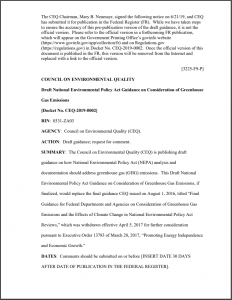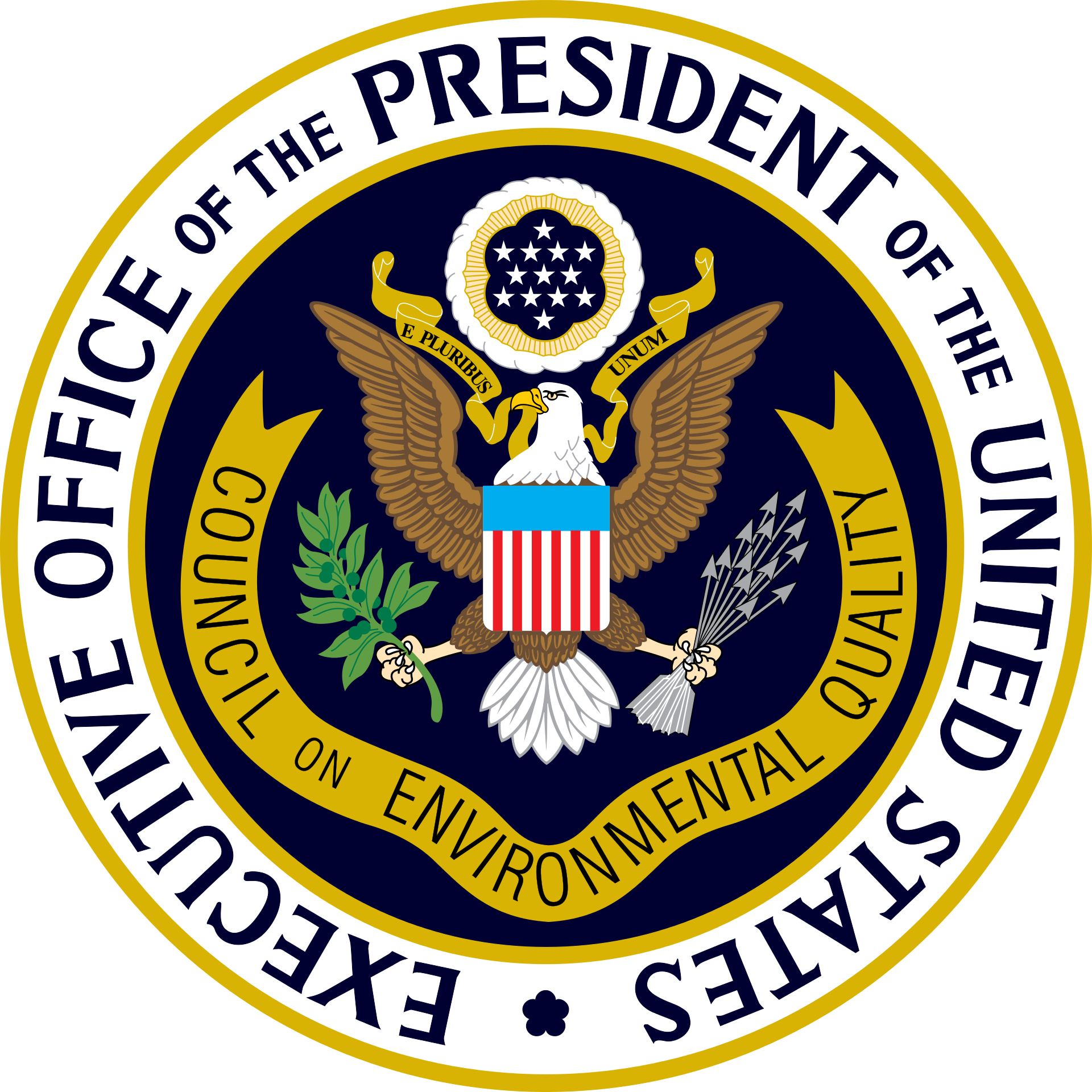 On Friday the White House Council on Environmental Quality (CEQ) unveiled new draft guidance on the consideration of climate change in National Environmental Policy Act (NEPA) reviews. This is intended to replace the final CEQ guidance that was issued by the Obama administration in 2016 and subsequently revoked by President Trump. As with the 2016 version, this new draft guidance reflects CEQ’s interpretation of NEPA requirements but does not in and of itself create new legal obligations or affect existing obligations.
On Friday the White House Council on Environmental Quality (CEQ) unveiled new draft guidance on the consideration of climate change in National Environmental Policy Act (NEPA) reviews. This is intended to replace the final CEQ guidance that was issued by the Obama administration in 2016 and subsequently revoked by President Trump. As with the 2016 version, this new draft guidance reflects CEQ’s interpretation of NEPA requirements but does not in and of itself create new legal obligations or affect existing obligations.
The draft guidance is not as significant a departure from its 2016 predecessor as one might expect based on other actions that the Trump administration has undertaken to roll back federal climate protections and advance its pro-fossil fuel agenda. The draft guidance acknowledges that greenhouse gas (GHG) emissions are an environmental impact, that both direct and indirect GHG emissions should be quantified where it is practicable to do so, and that “comparing alternatives based on potential effects due to GHG emissions… can help agencies differentiate among alternatives.” It also acknowledges that agencies should account for the effects of climate change on baseline environmental considerations where that analysis would not be overly speculative. These provisions are generally consistent with judicial interpretations of what NEPA requires.
The draft guidance does contain a number of statements which appear aimed at limiting NEPA disclosures of GHG emissions and climate change impacts, but these are unlikely to have a significant effect on agency practice or judicial review for several reasons: (i) as noted above, the guidance does not carry the same legal force as the statute or implementing regulations; (ii) the guidance does not represent a major departure from current agency practice, and (iii) many of these statements are too vague to contain meaningful instruction.
For example, on the subject of GHG quantification, the draft guidance directs agencies to quantify emissions where they are “substantial enough to warrant quantification” (presumably seeking to curtail quantification) without providing any guidance on what is meant by “substantial enough” in this context. It also tells agencies that impacts should be “discussed in proportion to their significance” and tells agencies that they “need not give greater consideration to potential effects from GHG emissions than to other potential effects on the human environment.” This is simply a restatement of NEPA requirements: agencies need not give greater consideration to any particular type of effect as a general matter, but they must conduct a more in-depth analysis of potentially significant impacts.
With regards to the scope of the required GHG disclosure, the draft guidance states that a “but for” causal relationship is not sufficient to establish that emissions qualify as effects of a federal proposal. This may be an attempt to limit the disclosure of downstream (e.g., combustion) emissions from fossil fuel production and transportation projects. However, this interpretation of NEPA requirements flows directly from the Supreme Court’s decision in Department of Transportation v. Public Citizen, 541 U.S. 752 (2004), which held that an agency need not consider environmental effects in its NEPA review when it has “no ability” to adopt a course of action that could prevent or otherwise influence those effects. Reviewing courts have held that this case is not applicable to federal approvals for fossil fuel production and transportation infrastructure because the reviewing agencies do have the power to act on information about downstream emissions from fossil fuel use when deciding whether to authorize such proposals. See, e.g., Sierra Club v. FERC, 867 F.3d 1357 (D.C. Cir. 2017).
With regards to NEPA’s requirement to evaluate cumulative effects, the draft guidance states that agencies satisfy this requirement by comparing GHG emissions to local, regional, national, or sector-wide emissions estimates and providing a qualitative summary of the effects of GHG emissions. This may be true for some types of projects, but more may be required when agencies are reviewing fossil fuel leasing decisions or transportation infrastructure. There are at least two recent decisions in which courts have required quantification of cumulative emissions from federal fossil fuel-related approvals in this context. See WildEarth Guardians v. Zinke, No. 1:16-cv-01724 (D.D. C. 8/25/18) (requiring BLM to disclose cumulative emissions from all reasonably foreseeable BLM lease sales in the region in its NEPA review for eleven oil and gas lease sales); Indigenous Environmental Network v. U.S. Dept. of State, No. 4:17-cv-00029 (D. Mont. 11/8/18) (requiring the Department of State to disclose emissions from the Alberta Clipper pipeline as part of its cumulative effects analysis for the Keystone XL pipeline).
Finally, the draft guidance contains a section on the “use of cost-benefit analysis” which is clearly aimed at support agency decisions not to disclose the social cost of GHG emissions in their NEPA reviews. The draft guidance correctly states that NEPA does not require a cost-benefit analysis. It then proceeds to explain that the social cost of carbon (SCC) estimates were “developed for rulemaking purposes to assist agencies in evaluating the costs and benefits of regulatory actions, and were not intended for socio-economic analysis under NEPA or decision-making on individual actions.” It is true that the SCC estimates were developed in the rulemaking context, but this has little bearing on whether the SCC estimates are helpful disclosure tools for project-level NEPA reviews. Either way, this provision is unlikely to have much effect as agencies already use this argument as a justification for not disclosing social costs of GHGs in their NEPA reviews.
One thing that the draft guidance fails to acknowledge is that, although NEPA does not require a cost-benefit analysis, it does require agencies to conduct a fair and balanced assessment of costs and benefits if the agency voluntarily discloses these. Courts have therefore required agencies to disclose the social costs of GHG emissions where they have also monetized economic benefits such as royalty revenue and labor income from fossil fuel leasing. See, e.g., High Country Conservation Advocates v. USFS, 52 F. Supp. 3d 1174 (D. Colo. 2014); Montana Environmental Information Center v. Office of Surface Mining, No. 9:15-cv-00106 (D. Mont. 11/3/17). Likely in response these court decisions, the draft guidance states that: “[m]onetization or quantification of some aspects of an agency’s analysis does not require that all effects, including potential effects of GHG emissions, be monetized or quantified.” But it does not provide any insight on the threshold at which quantification or monetization of GHG emissions may be necessary for a full and balanced assessment of impacts under NEPA.
CEQ will be accepting public comment on the draft guidance for a period of 30 days after it is published in the Federal Register. Interested parties can submit comments at regulations.gov (Docket ID: CEQ-2019-0002).



